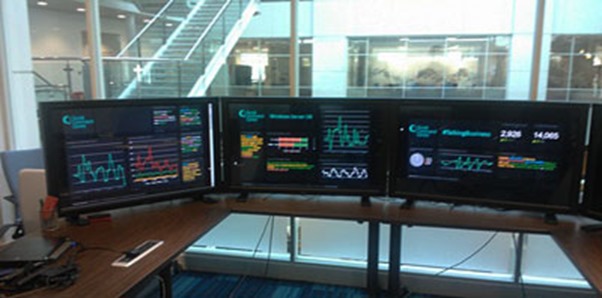The Social Command Centre—a kind of NASA Ground Control for social media hub teams in organisations—is an increasingly common sight these days inside large organisations. Here’s a snap of Microsoft’s latest prototype, which I saw running on a visit this week to their UK Campus:
The big idea behind command centres like this is to provide an at-a glance view of interesting things happening on the social web. In Microsoft’s case this equates to monitoring their own accounts across a variety of channels as well as any trending social chatter about selected products and services,
In reality though, having a whole bank of screens—I’ve seen as many as twenty—creates a wall of data that is sometimes very hard to analyse and understand without an army of community managers and data analysts. Unless you’re running a presidential election or overseeing a high-profile public event with millions of viewers, the chances are an oversized command centre may eventually prove as useful as an inflatable dartboard.
There’s is, however, a different purpose that a wall of screens can serve, and that’s to create a focal point for the company’s social media listening and response activities. For Microsoft, the monitors you see above help remind staff and executives that there’s a world outside of the corporate headquarters. Making a public show that you’re listening to the chatter and working hard to engage with customers in real-time sends a powerful signal across the organisation. This was the guiding principle behind Nokia’s social visualiser Agora (watch video), which was placed in public areas like staff canteens and thoroughfares within their office locations.
Of course, the Social Command Centre isn’t a new idea. Many other companies including Gatorade, Salesforce, Dell and NVIDIA have all publicly showcased monitor-laden operations centres. But for many the question remains, is this actually a useful tool for improving the effective use of social media marketing, a cheap way to inject outside influence onto an internal organisational culture or just an extravagant way to lend social media a much-needed air of credibility?
What do you think?


Comments
5 responses to “Who Needs a Social Command Centre Anyway?”
Personally I believe our “social media command centre” has been extremely effective at highlighting the importance of social media internally at Dell. It has served as a focal point for both our staff and some of our customers, highlighting that “we are listening” and more than that, “we want to engage”.
Customers should be central to what we do and so, to my mind, anything that works to shift corporate culture away from operating in an insulated manner and towards being more open, more proactive and more engaged with it’s customers is a good thing.
If this takes the shape of some pretty graphs and numbers, then who am I to argue.
I’d have to echo what Richard said here… What you don’t see in most cases, though, is the ways in which the data and learnings are enabling teams to be more involved with the people they are focused on – the customer. If you look at brands like Dell and others, they’re using all that data and insight to create better products and experiences for their customers, not just to go through the motions. That’s the goal, I’d think, of any business looking to move up the social maturity ladder.
Full disclosure: I work on this project with Microsoft.
Agree with Richard. I have been quite open about the purpose of the screens but it is incredible the number of people that stop as they walk past to learn more and some of these are senior people. The screens don’t show the level of work that needs to go on behind the scenes to get the right social strategy, processes and solid foundations, but anything that is a conversation starter is a winner in my books! I also often talk about how the social community managers are one of the great roles that can bring the “outside in” rather than the other way around. They can bring the voice of the customer to internal teams and ensure a sense of “realism”
I’d echo the comments above. A highly visual, physical social media command centre can act as a clear and overt statement of an organisation’s commitment to acting more socially: to listening to its stakeholders, learning from their conversations and responding in an appropriate and timely way. If it stops people and starts a conversation in its own right, then even better.
Back in the day (and this was more than a dozen years ago) I was involved in the running of the Microsoft Press Office at the UK HQ. Six full-time press officers house in a glass-walled room right next to the main reception, monitoring media, responding to journalist calls and emails, finding the most appropriate employee to act as spokesperson. Not only did it deliver the right service, it did so in a way which demonstrated a clear commitment to this group of stakeholders. It also became a focal point for people across the organisation when news was breaking (about Microsoft or anything else!)
There are clear parallels with the idea of the social media command centre. It’s where the organisation can be seen to be plugged into the outside world. And in a social environment, where a business must show it is being influenced by its stakeholders as much as it is influencing them, it can be hugely valuable.
I think that would be amazing. I can imagine screens large enough to be seen from outside the room constantly displaying mentions of Microsoft on the social web, linking announcements, coverage and activity to the social conversations they prompt and demonstrating how Microsoft is listening and responding in real-time. Compelling stuff.